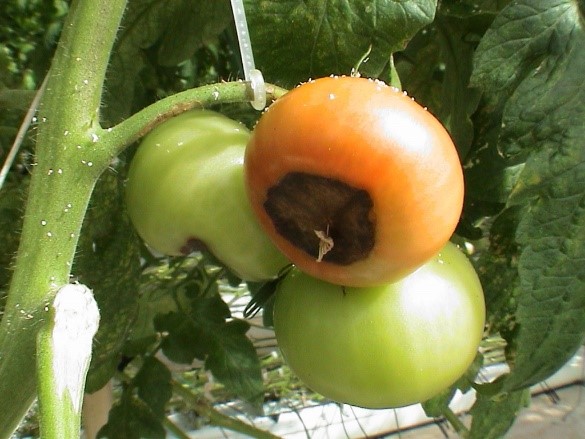Common tomato problems in the garden

WAYNE COUNTY — Many gardeners enjoy the excitement of awaiting that first fresh tomato out of the garden. Unfortunately, there are some common problems that occur on tomatoes as we have fluctuations in rainfall and temperatures.
One of these common problems is when tomatoes turn brown on the bottom just before they begin to ripen. When this spot is noticed it is often thought that a disease is causing the rot to occur, but in fact what is occurring is referred to as blossom-end rot on tomatoes. Blossom-end rot is not a disease but instead a nutrient deficiency. The nutrient that is lacking is calcium.
Blossom-end rot will be a rot that is dark brown in color and has a tough, leathery feel. The rot will be on the blossom end of the tomato fruit. The spot is usually about the size of a dime and enlarges to the size of a half-dollar. Typically, blossom-end rot is worse on the first fruit that develops but it can also occur throughout the season.
There are a couple of things that can cause calcium to be deficient in the tomato. One way is if soil pH is too low which would cause calcium to not be available to the plant. Dry weather or improper watering practices can also contribute to a calcium deficiency in the tomato fruit. Tomatoes require about one inch of water per week. Extreme fluctuations in soil moisture (either too dry or too wet) result in a greater incidence of blossom-end rot. Inconsistent soil moisture is often the main contributor.
Of course the question is, what can be done to prevent or correct blossom-end rot. As far as correcting goes, the tomatoes already affected will continue to be deformed. They are safe to eat, but it reduces the amount of tomato that can be used. If you have a lot of tomato plants with blossom-end rot, it might be good to pick off and get rid of the fruits that are severely affected.
When blossom-end rot is first spotted, spraying a calcium solution (Tomato Saver, Blossom-end Rot Preventer, Stop Rot) will help reduce blossom-end rot on later tomatoes. Ideally, calcium spray should start when the first green tomatoes are about the size of a silver dollar. Check the label for how much and how often you should spray.
If blossom-end rot is a recurring problem each year, you should get a soil test to see what the soil pH is. If the soil pH is too low, calcium is not available to the plant. Optimum soil pH for tomatoes should be 6.5 to 6.7. Adding lime to the soil will increase the soil pH and add calcium to the soil. Getting a soil test will be the only way to determine for sure what your soil pH is and how much lime you should add. Soil test kits are available at the Wayne County Extension Office.
Proper watering and fertilizing practices are important in reducing blossom-end rot. Mulching around plants will conserve soil moisture and reduce moisture fluctuations in the soil. Avoid applying too much fertilizer at one time and avoid high rates of nitrogen fertilizer.
Another common problem is when cracking or splitting occurs on tomatoes. The cause for cracking on tomatoes is usually an environmental problem. Some of the common reasons cracking occurs on tomatoes is fluctuations in watering and temperature or fast growth due to excess nitrogen fertilizer.
Unfortunately there is no treatment that will undo the cracking on tomatoes. There are a few things you can do to prevent the problem in future growing seasons. Be sure to water on a regular schedule as much as possible. Although it is hard to prevent too much rain at one time, you can control how much you irrigate your tomatoes to prevent soil and plants from drying out. While tomatoes do need fertilizer, avoid fertilizers heavy in nitrogen during fruit development. Too much nitrogen during this time will encourage fast growth.
Although tomato blossom end rot, cracking or splitting cannot be completely eliminated, paying close attention to these few things can make these problems occur less often on those home grown tomatoes.
From the Wayne County Cooperative Extension website, by Extension Agent Jessica Strickland



